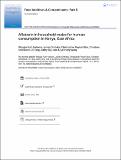Aflatoxin in household maize for human consumption in Kenya, East Africa
Publication Date
2019Author
Wangia Ruth Nabwire, James Ombaka, Christopher Peyton Dick, Christian Strickland, Lili Tang, Kathy Siyu Xue & Jia-Sheng Wang
Metadata
Show full item recordAbstract/
The objective of this study is to determine the occurrence and level of aflatoxins (AFs) contamination in freshly harvested maize for human consumption in rural Kenya. Maize kernels and
freshly milled maize flour (n = 338) were collected from households in Siaya and Makueni
counties. While both counties are representatives of different environmental and climate conditions, Makueni County is the area with reported outbreaks of aflatoxicosis. Samples were analysed
for AFB1, AFB2, AFG1, and AFG2 using Ultra High-Pressure Liquid Chromatography with
Fluorescence detection. AFs were detected in 100% of the samples with the range of 2.14–411
µg/kg. The geometric mean of total AFs in all samples from Makueni County is 62.5 μg/kg with
95% CI: 53.7, 71.4 while in Siaya County is 52.8 μg/kg with 95% CI: 44.0, 61.7. This study showed
that AFs contamination is prevalent in maize-based foods in the region.

